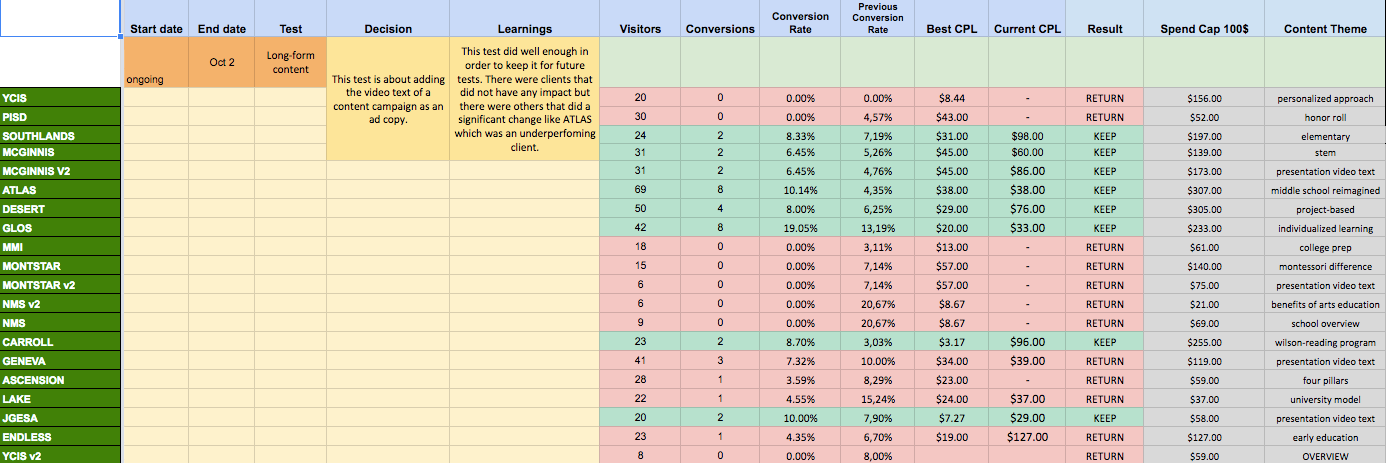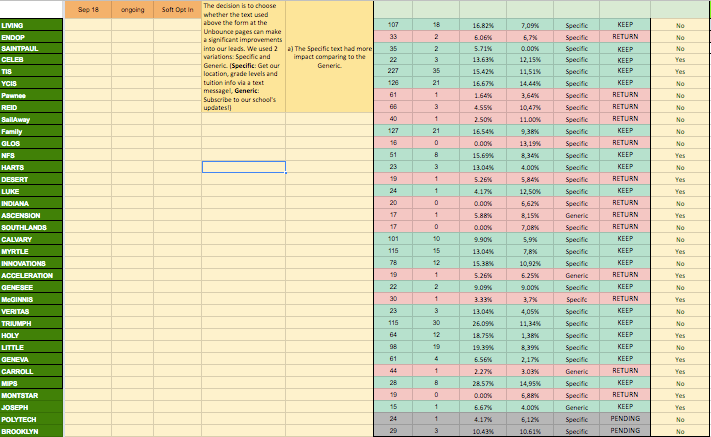The Enrollhand Testing Method
Every week we run at minimum 20 experiments for 10 different clients.
We make sure that we choose clients from different performance groups: three from our top 10% performing clients, three from our middle performing clients and three from our bottom 10% performing clients.
We track ad clickthrough rate (CTR), landing page conversion rate (CR) and Cost Per Inquiry (CPI) using the typical excel sheet.
Every Friday, we sit down to evaluate our results and decide if we are going to KEEP the tested changes or RETURN to the previous setup. We also determine if we are going to roll-out the changes to additional clients.
Here are a few of our past campaign tests:

1. Redesigned Landing Page enhanced with children's image gallery and lightbox CTA
We did not want to include additional information about the school on the Landing Page.
In a past experiment (July 2018) we confirmed that adding information beyond a certain point significantly reduced conversions as a result of:
a. increased distraction/confusion for the visitor to our landing pages
b. parents were getting enough info without needing to start a conversation with our school
Results: One out of 13 schools in the experiments saw a limited improvement.
Insights: Parents were getting a lot of visual content already at the ad level so additional photos or footage on the landing page does not provide any added value.
We change up campaigns every couple of weeks (depending on how frequently parents have already seen the ads that are running) so parents already get a healthy dose of the school's facilities, staff, vibe etc.

2. Switching our ads from short to long form
When creating Facebook ads, most of the image has to fit within certain limitations.
For example, the image has to be a set ratio and size.
The headline and the link description have to be a certain length otherwise they get cut off.
That leaves the ad's body text as the primary variable.
It can be just a single word or the equivalent of a short story.
As the ad text has so many possibilities, we get asked all the time at Enrollhand which length is best?
So we invested $7,642 of ad spend to get a scientific answer.
Results: This experiment was a 'keeper' for 8 out of the 20 schools in the sample. Some clients did not see any improvement [12 out 20] while there were others that saw a significant change [8 out of 20].
Using these experiments, for example, we were able to completely turn ATLAS around who had been underperforming for three consecutive weeks. ATLAS Cost per Inquiry has since stabilized at -74% compared to the previous period.
Insights: For clients hovering around a 5% conversion rate, increasing the body text in our ads added on average of about 4% to their performance.
Clients who had already broken the 5% threshold saw little or no improvement.

3. Softer opt-in with reduced 'ask'
In this experiment, we were testing whether requiring a smaller commitment would boost conversions. We switched the copy in our ads' Call-to-Action and the inquiry form from 'Get In Touch' to 'Receive more info' (location, grade levels, and tuition) or 'Subscribe to our updates.'
We tested this approach on a total of 35 clients.
Results: We saw significant improvement in 20 out of the 35 schools in the experiment.
The exciting part of this was that our follow-up via text message and phone calls revealed these parents to be equally if not more responsive -leading to campus tours and enrollments.
Insights: When a parent opts into a softer ask they may very well be interested in being contacted. At the campaign level, we should be focused on initiating the conversation. After that, a light text message follow-up is ideal for gauging whether the parent is simply browsing or actually shopping around for schools.
